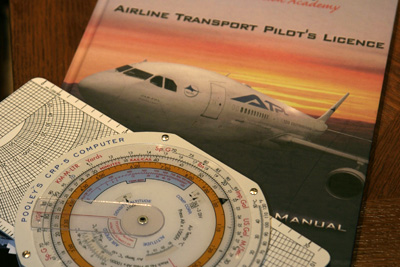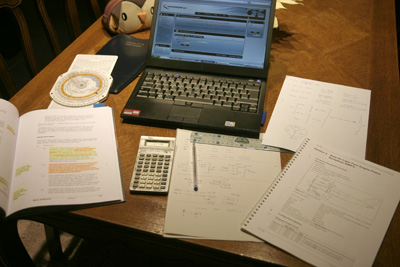Yes, I have made the decision: I want to continue feeding my Flying Frenzy, so I want to continue obtaining ratings and licences. I am a strong believer in continuous learning and training in order to further improve safety. The last serious rating I added to my Private Pilot License was the Instrument Rating, which was onto my American FAA Private. This is about 2 years ago in the meanwhile, and yes, it was a hard but rewarding experience. In the foreseeable future, we will stay in Europe, so I have also decided that I will work on European Licenses or Ratings, say JAA, JAR, EASA or whatever the next acronym will be. Some months ago I obtained my Class 1 Medical, a prerequisite for further commercial licenses.
The next step up the License/Rating ladder is the JAA Night Rating, which I do not hold for the moment. I am however allowed to fly at night with American N-registered airplanes, but not with European ones yet. Adding a Night Ratings feel very straight-forward: it’s a matter of blocking some evenings for flight training, and paying of course. Most probably, this is the first one on the list.
The next thing up is a Commercial License. This is the first step of the professional ladder. It does not give you a lot of priviliges as a captain, but it’s all you officially need to be the first officer on an airliner. You can do solo banner-towing, paradropping, sight-seeing flights against payment. If you want to get paid as a flight instructor, you also need a commercial pilot license (CPL). There is a theory course to be done, and a practical course. Both end with an official exam.
Then most of the linepilot wannabees add an Instrument Rating (IR) and a Multi-Engine Rating (ME) to their CPL ticket (or do a combination). The IR requires a dedicated theory course + exams. A CPL + IR + ME gives you official access to the right seat of an airliner (if you add a Multi-Crew Course (MCC) too). But the pilot labour market precludes access to most licensed pilot unless you can prove substantial additional experience, and almost always you also need the right Type Rating (TR). Let me be clear that it is not my ambition or goal to go fly airliners !
Most professional pilots combine all professional theory courses into one course: the ATPL, or better ATPL(A) for aircraft, as this is different to ATPL(H) for helicopters. This course combines the theory courses for CPL(A) and IR, plus once you have obtained 1500 hrs of flight (+ some other requirements), you do get issued your ATPL License, the Airline Transport Pilot License, the pinnacle of pilots licenses. This license allows you officially to become Captain of an airliner, provided your employer believes that this is the good moment for a promotion too.
So last year, I was considering my options, and instead of doing the CPL theory course, I told myself that going for the ATPL Theory Course can’t be that much harder … So I decided to subscribe to an ATPL(A) Theory Course! I have alwyas been good in studying, so I thought that itw ouldn’t be that hard and that I know a lot of aviation already … Boy was I wrong !!! The JAA ATPL Theory Course has some mystique around itself: it’s known to be very difficult, too broad, too much, too theoretical, not always relevant and not always complete. Let me assure you that this is all true…. but I loved it as soon as I opened a book !

So having made the decision to start the ATPL, there were two further decisions to be made: Distance Learning or Classroom …and at which school ? For ATPL, there are basically three systems: the Integrated route whereby a student basically does all theory, practical learning and all licenses and ratings in one curriculum in one school: the non-stop route towards the right seat of an airliner. This is as if you would do a full-time Master Degree, so impossible for me. The second route is the Modular Route: you do all licenses and ratings one by one as you go. Ideal for people who work already, or who one to take things one step at the time … perfect for crazy people like me. Within the Modular, you can choose for Distance Learning (= minimal classroom attendance) and Classroom (= well … you have to attend classroom). I have a very bad life record in attending classrooms, and I don’t have spare time at decent hours (I only have spare time late at night after having taken care of the family and work, or when on the road for my real job), so it was obvious for me to go for the Distance Learning option.
For the JAA ATPL(A) Distance Learning in Belgium there are three main avenues: the courses developed by the Belgian company Aviation Academics, the courses from Oxford Aviation Academy (UK) and those written by Bristol Groundschool (UK). Several schools in Belgium support one or the other. I was looking for a course that was of high quality, not delimited by school-years (i.e. which I could start any time at my choice) and which meant minimal classroom attendence as I don’t have spare time … So after checking around, I choose the ATPL(A) Distance Learning Course by Hub’Air in Brussels, which is basically the Bristol Groundschool course.

The Bristol Groundschool Distance Learning Course is nicely worked out. There are 14 courses (so 14 exams) to be studied, and they are spread over 13 books, some thick others thin. The course is split into two blocks:
| Block A | Block B |
| General Navigation | Aircraft General Knowledge |
| Radio Navigation | Aviation Law |
| Performance | Operational Procedures |
| Principles of Flight | Instruments |
| Flight Planning | Meteorology |
| Human Performance & Limitations | VFR Communications |
| Mass & Balance | IFR Communications |
All content in the books is also available on the PC after a DVD installation, but I learn better from books which you can color and annotate.With every chapter you get progress tests on your PC, which you have to pass before you can continue studying. This kind-of forces you to do a good job – the learning discipline is built into the Bristol system. On top, the results get reported to the flight school which can track your progress, but so far that has been more a formality.
Now, I have finished studying Block A. I feel that I am rather ready to go sit the official exams in Brussels. How do I get this feeling? Well, basically once you have studied one or more courses, you can sit for an unofficial exam in front of your computer and test yourself with real questions. There are multiple question providers around: you need to pay to get access to their library of questions. I have chosen for AviationExam.com, a Czech website: it’s well organised, you can keep track of your progress and you can read and share comments with other users … you’re part of a community. They have more then 15’000 ATPL questions gathered. For those puretans who consider this cheating … first of all try to do without (good luck!) … and secondly, those who can learn 15’000 answers by heart deserve a Nobel Prize anyhow. I will be happy to have seen 10% of all questions before I enter the real exam … but at least it gives me a taste, a direction and feedback how well I studied.

You need to pass these multiple choice exams with 75% minimal score. My experience so far has been rather humiliating ! It is hard stuff! I thought I knew something about aviation and I am a licensed electronics engineer, but it turned out that I didn’t ! It also took a while to get into the study rythm after not having studied intensively for many years. The multiple choice questions are designed in such a way that you need to know your stuff very well. Common sense, luck and good thinking won’t be enough to succeed.
As a Distance Learning student, you are on your own basically. It’s a lonesome thing, you spend hours at night and it’s hard to get feedback. I have sit for one of the two revision courses at Hub’air in Brussels for a week, and the best part of that was seeing that other students also sweat and ponder. We were with 6~7 lonesome students from literally all over the world (I was a local for once), and quickly we became a tight group helping each-other out. Every course was revised during that intensive week, albeit that some courses were being more revised than others …
Let me go quickly over my impressions of the courses itself of Block A:
General Navigation
Very interesting course full of deep dark secrets like how to navigate over the Poles. Lots of small exercises. You learn to appreciate goniometry again (sinus ! cosinus ! tangens !). Bonus: the Inertial Navigation Systems will not hold any secrets anymore.
Radio Navigation
Effective course full of minute details on how all radio navigation works. Always wondered what Loran-C might be? Curious on Mode-S or WAAS: here you find all the answers. Plus: did you know that the dead area over a VOR extends to 50° ? Now you know !
Performance
A big new-new to me. These big iron guys actually calculate EVERY aspect of their take-off and landing! All risks are reduced to one in a million. Difficult, but rewarding course. Hate it in the beginning, now love is starting to grow. Want to know why airliners overshoot runways from time to time? Gross Performance of course…
Principles of Flight
Ah, you thought you knew why airplanes fly … think again because here comes Principles of Flight. All details are being revealed, be ready to learn about flight in transonic regime, why all speeds go down when flaps come down and go up when mass goes up. And of course, you learn about the dreaded P-factor!
Flight Planning
God I love doing test-exams for this one: you have three hours for 59 or so questions. And all questions are tricky ang long. But if you are disciplined and you do everything by the book, you succeed very well. Here you learn all about Transatlantic Flight. Not that I will ever need it, but when we call Gander or Shannon on my next flight towards the US, I will understand (when listening to channel 9 on a United Airlines 767).
Human Performance & Limitations
This course is your last chance to change profession: if you want to become a medical practisioner, study this one first. Learned a lot … about middle ears, centralised decision makers, how stress is good and bad and why you should not drink alcohol before or during a flight (god beware!). Did you know Ozone (O3) is actually a poisonous gas?
Mass & Balance
This is the thin and easy one. It’s just easy. Not that I always get good results, but it’s easy.
Stay tuned for further updates on my ATPL adventures … Any questions? Just mail !


Hello,
I have FAA private pilot license. I want to take EASA ATPL distance learning course. Do you have any attendance requirements ? Are the exams taken defined dates?
What is the totally price of this course with exam fees? Could you give more information about this course?
Best Regards,
Kutay Gulbiten
Dear Kutay,
I do not offer ATPL courses. I am just another private pilot with a blog.
Thanks for your reaction & safe landings!
Steven